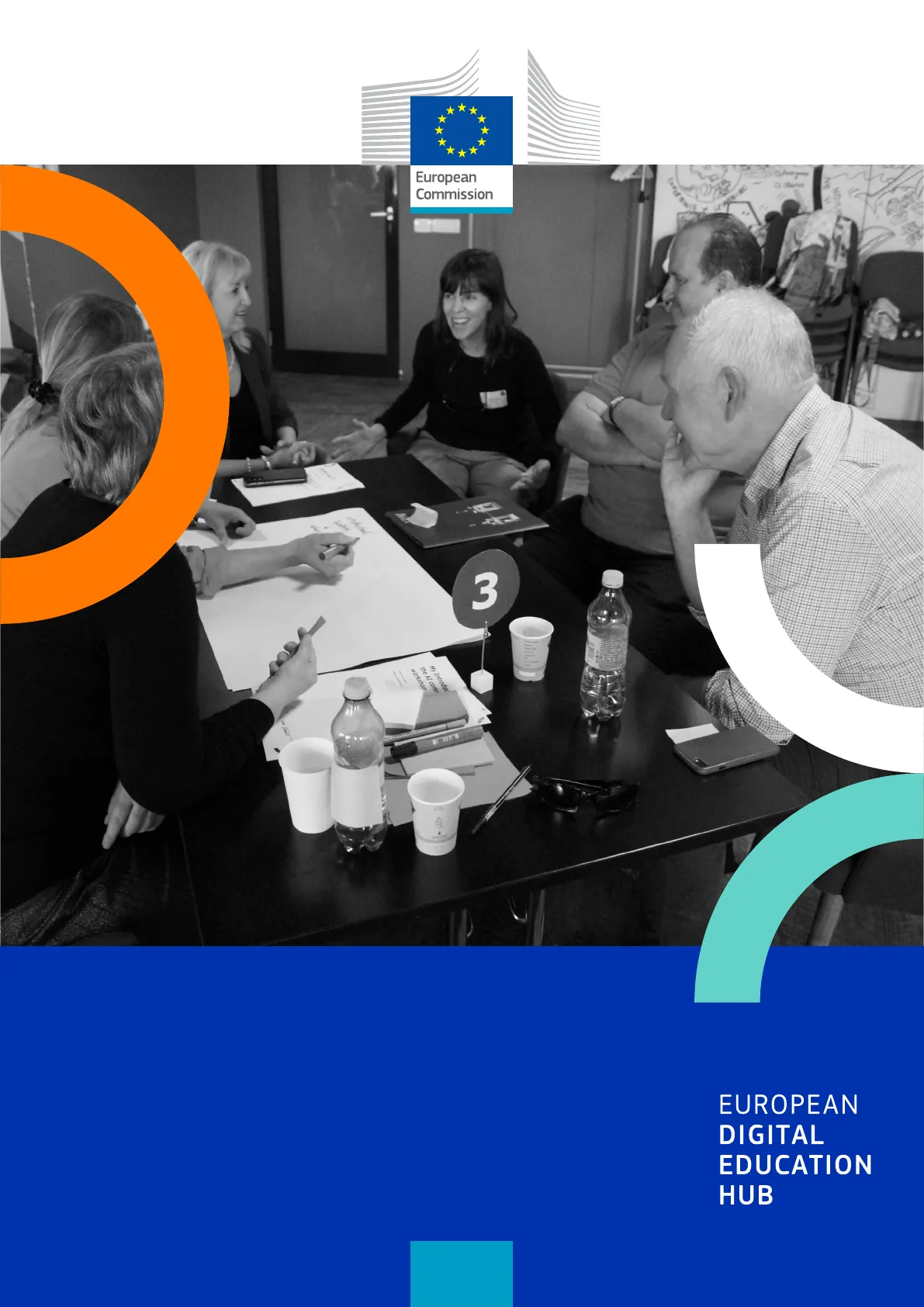Use Scenarios and Practical Examples of AI Use in Education by European Commission
Pdf from European Commission about Use Scenarios & Practical Examples of AI Use in Education. The Material explores the application of AI in teaching, distinguishing between teaching AI and teaching with AI, presenting specific use scenarios and practical resources for teachers and students in computer science for adult education.
See more22 Pages


Unlock the full PDF for free
Sign up to get full access to the document and start transforming it with AI.
Preview
Introduction to AI in Education
An initiative of the European Commission IS AN NOISA 3 workshop the AI comr My Introduc Use Scenarios & Practical Examples of AI Use in Education Briefing report No. 3 by the European Digital Education Hub's squad on artificial intelligence in education EUROPEAN DIGITAL EDUCATION HUBThe European Digital Education Hub (EDEH) is an initiative of the European Commission, funded by the Erasmus+ programme (2021-2027) and operated by a consortium of 11 organisations under a service contract with the European Education and Culture Executive Agency (EACEA).
Content Overview
Report Structure
Content Introduction and Report Organisation 4
Teaching Approaches for AI
Teaching for AI 6
Use Scenarios for AI in Education
Use Scenario 1: Bias on AI Algorithms 8 Use Scenario 2: Computational Thinking and Algorithms 10 Use Scenario 3: Data Privacy and AI 11
Teaching about AI Fundamentals
Teaching about AI 12 Use Scenario 1: Representation & Reasoning in Al 13 Use Scenario 2: Recommendation Systems 14 Use Scenario 3: Teaching Machines to Classify 15 2Teaching with AI 16 Use Scenario 1: Automatic Content Generation 17 Use Scenario 2: Intelligent Tutoring Systems 19 Use Scenario 3: Automatic Translation of Conversations 20
Recommendations for AI Education
Recommendations by the Squad 21 3Introduction and Report Organisation This report presents a set of use scenarios based on existing resources that teachers can use as inspiration to create their own, with the aim of introducing artificial intelligence (AI) at different pre-university levels, and with different goals. The Artificial Intelligence Education field (AIEd) is very active, with new resources and tools arising continuously. Those included in this document have already been tested with students and selected by experts in the field, but they must be taken just as practical examples to guide and inspire teachers' creativity.
The use scenarios have been organised in three main categories, according to the three main approaches followed in AIEd:
Teaching for AI entails competences for all citizens, including teachers and learners, to engage confidently, critically, and safely with AI systems to provide them with the necessary knowledge, skills and attitudes to live in a world surrounded and shaped by AI.
Teaching about AI is the more technical part, focused on training students in the fundamentals of AI. It is usually part of AI literacy which should comprise both the technological and the human dimensions of AI organised according to the student's age. Knowledge about Al basics is key for preparing students for the labour market, independently of their future careers.
Teaching with AI focuses on the application of AI-based tools for educational goals. These types of tools provide autonomous support to students in different aspects of learning, facilitating teachers' work. Moreover, they can also support teachers and institutions in management and supervisory tasks. The main goal in this category is not to understand the technology behind these tools , but to take advantage of the potential of AI to enhance teaching and learning. 4While the third category is quite clear, the difference between the first and second could be confusing for teachers. Teaching for AI implies training students in all the AI topics from an AI user perspective, rather than an AI developer perspective, which will be covered in the Teaching about AI section. We could differentiate these two perspectives with the following key ideas:
- In terms of curriculum, teaching about AI should be included as specific subjects or courses (or part of them) with a detailed program covering the main AI topics (perception, actuation, reasoning, representation, learning, impact, etc.). The learning outcomes are more technical and specific, so before learning about AI, students should receive background training in maths, programming, and other technical knowledge required to properly understand the AI topics from a developer perspective. Teaching for AI could be organised in a more transversal manner through embedding it in different courses and areas (e.g., language, history, natural sciences, mathematics, arts). The learning material could be organised as small activities within different subjects (not only technical), or as specific subjects where the AI topics are delivered without relying on deep technical aspects (like programming). Learning for AI does not require a specific background in maths or programming.
- . In terms of methodology, in teaching about Al, students develop simple Al-based solutions by programming them, while in teaching for AI, they can focus on analysing existing AI-based applications or tools by using them, understanding the way they work and their impact.
- . In terms of specialisation, teaching for Al is necessary for all students, independently of their area (humanities, science, engineering, arts). Teaching about AI could be targeted to technical paths, thinking about those students interested in working as "Al engineers". Hence, teaching for Al is a pre-requisite for educators and learners before moving to teaching about AI.
The following 3 sections contain selected use scenarios in these categories that exemplify their differences and opportunities at classes. 5Teaching for AI In this section we describe projects and learning scenarios that provide activities for teachers to engage students in activities that improve knowledge, skills, and attitudes towards how AI systems are used in today's society, and focus on everyday applications that are driven by Al. To teach for Al use in everyday life, the focus is two-fold:
- to introduce some basic principles to keep in mind when interacting with common AI applications, such as virtual assistants and recommendation systems, to mitigate risks related to safety, personal data, privacy and well-being;
- to become aware of how AI is used in various parts of our society, e.g., autonomous vehicles, medicine, industry, agriculture, and creating realistic expectations about what AI systems do and do not do.
This is a key topic, and students should be aware of the limits of AI from a formal perspective, mainly understanding the differences with human intelligence.
When creating lesson plans to teach for AI, areas that are part of the DigComp framework can become helpful. Especially understanding Al's impact on information, data and media literacy is crucial due to disinformation on social media platforms and other new forms of automated AI -generated content that exists on the internet.
AI literacy and digital citizenship are essential topics to cover and should include examples for responsible use of AI and data-driven technologies, with a critical mindset to be aware about the potential biases and limitations of such systems. Here, an important goal is to help people navigate ethical questions related to digital practices - like the question of human autonomy which underpins many of the EU values. 6At a certain student age, the inclusion of legal topics such as personal data protection (GDPR) and privacy, ethical considerations in data collection, storage, and usage, and bias and fairness in AI algorithms will be important.
It could also be useful to include examples about AI applications in tools and services, including using AI-powered tools for productivity, communication, and entertainment, integrating AI services into custom applications using application programming interfaces (APIs), and evaluating AI services for data privacy and security concerns. Similarly, introducing students to methods of exploratory data analysis through descriptive statistics and data distributions, data visualisation techniques and tools such as bar charts, pie charts, and scatter plots, and making data-driven decisions based on analysis and visualisations could be useful as well.
Teaching for AI can also include aspects such as understanding the nature of different types of data (structured, unstructured, and semi-structured), data formats (text, images, audio, and video), and data sources (public datasets, APIs, and web scraping), and more technical concepts of AI such as machine learning and deep learning. 7Use Scenario 1: Bias on AI Algorithms
Bias in AI Algorithms: Idea and Target
Idea:
- Explaining to students the bias that can be introduced in machine learning if data are not properly selected and analysed, and how it can have a relevant impact on automatic decision systems.
- . Why: to introduce them to the impact of Al.
- · How: by means of a developing and analysing simple decision systems.
Target level: upper primary school and secondary school (ages 8 to 18). Topic: machine learning
Resources for Bias in AI Algorithms
Possible resources: Name: A Fresh Squeeze on Data
- Target level: ages 8-10
- . Link: https://freshsqueezekids.com
- · Description: This lesson is intended to provide student awareness of bias and their relationship with data. As a demonstration, this lesson allows the teacher and the students to explore and experiment with data bias. The teacher will explain why data is important, how to collect data, what is bias and its relationship with data. The lesson will conclude by asking students to imagine practical, real-life implications of data bias.
Name: AI + Ethics Curriculum for Middle School
- Target level: ages 10-14
- · Link: https://docs.google.com/document/d/1e9wx90Bg7CROs507YnYHVmX7H7pnlTfoDxNdrSG kp60/
- · Description: On page 29 of this pdf file, there is a detailed activity with the required materials. Students will have to use an online programming tool (teachable machine), which does not require any previous experience on programming. 8J
Name: Our AI Code of Ethics
- Target level: ages 10-14
- · Link: https://studio.code.org/s/ai-ethics-2021/lessons/1
- · Description: This lesson belongs to the code.org initiative, and it builds on prior activities involving research and finding sources to justify an argument. In small groups, students conduct research using articles and videos that expose ethical pitfalls in an AI area of their choice. Afterward, each group develops at least one solution-oriented principle that addresses their chosen area. These principles are then assembled into a class-wide "Our Al Code of Ethics" resource (e.g., a slide presentation, document, or webpage) for AI creators and legislators everywhere.
Name: Build a Bot
- Target level: ages 14-18
- · Link: https://dschool.stanford.edu/resources/build-your-own-bot
- . Description: This facilitation guide includes a set of activities for children, families, and parents to experiment with the potential and peril of AI assistants. In this document there are three workshops with facilitator guides, slide decks, worksheets, and other materials. These have all been designed as unplugged activities and do not require a computer. 9